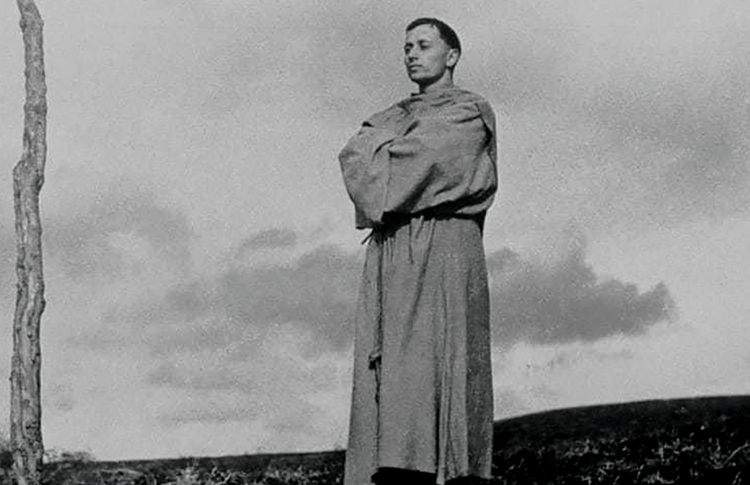All of our Catholic Movie Club films this month have been inspired by Pope Francis’ life and legacy. As we come to the end of May, it felt appropriate to cover the most famous film made about his namesake: Roberto Rossellini’s “The Flowers of St. Francis” (1950). It is one of the most well-regarded Catholic films in history, appearing on the Vatican Film List and praised by major filmmakers like Francois Truffaut, Pier Paolo Pasolini and Martin Scorsese.
It is also a strikingly simple film. Rossellini presents nine vignettes—parables, really—of Francis and his early companions, each illustrating the saint’s spirituality. It is not a biopic so much as a collage. From these stories, you can easily make connections between St. Francis’ spirituality and how Pope Francis led the church. As I reflect on what his legacy will be for us, moving into an uncertain future, this film inspired me to reflect on three key themes: simplicity, peace and joy.
“The Flowers of St. Francis” is an example of the Italian neorealist style that Rossellini helped to pioneer. This movement, growing out of attempts to rebuild Italian cinema following World War II, cut out the excesses of the earlier studio system in favor of something more simple and, they hoped, more real. They used real locations, minimal equipment and nonprofessional actors. In the case of “The Flowers of St. Francis,” Rossellini cast real monks from the Nocera Inferiore Monastery in Campania to play St. Francis and his companions (Dominicans, not Franciscans, for the record).
With its inherent simplicity, Italian neorealism is a perfect match for Franciscan spirituality. Francis (Nazario Gerardi) insists that he and his brothers never take more than they need, and are grateful for whatever they receive. They serve God by serving others. At the beginning of the film they return from Rome in a relentless rainstorm to the hut they built themselves, only to find a squatter who drives them away with threats of violence. “Shouldn’t we be rejoicing in our hearts?” Francis asks his distraught brothers. “It’s the first time Providence has made us useful to someone else.”
For Francis, all of life is bursting with God’s presence: He calls the birds his brothers (gently requesting that they quiet their singing so that he can pray) and weeps with gratitude after embracing a leper. Rossellini had a complicated relationship with Catholicism, to put it mildly, but this film evokes his great admiration for Francis’ (and Christ’s) teachings.
This great compassion leads, naturally, to Francis’ desire for peace. We see it throughout the film, but it is illustrated most strikingly in the vignette where Brother Ginepro (Severino Pisacane) encounters an army besieging a city. Throughout the film Ginepro—as eager and fumbling as St. Peter—longs to go out and preach. This is his big chance: convincing the army of the tyrant Nicolaio (Aldo Fabrizi, the only professional actor in the cast) to lay down their arms. Instead, his attempts at preaching are met with outrageous, comic violence that feels like a set piece in a Buster Keaton film (assuming that Brother Severino did his own stunts, he had a real gift for physical comedy).
While suffering this abuse, Ginepro finally understands something Francis has been trying to teach him: “souls are won not by words, but by example.” He submits cheerfully to whatever the barbarians throw at him—even to a sentence of death when he is dragged before Nicolaio. Confused at first, the tyrant is slowly overcome by Ginepro’s placid manner, and calls off the siege.
That scene also nods to the film’s playful sense of humor, which was a pleasant surprise for me—I don’t usually expect saint movies to be laugh riots. But it’s all in keeping with the joy that Francis preaches: the only reasonable response to God’s love and grace. The friars often act like a troupe of clowns or a group of children, embodying that simple, joyful faith. This tone also nods to the sensibilities of the film’s co-writer, director Federico Fellini, whose films are enlivened by similar humor. We began this month, in fact, with his own film on holy foolishness, “La Strada” (Pope Francis’ favorite film). But while that was a tragedy, “The Flowers of St. Francis” shows us holy joy undimmed by the violence and deprivations of the world around it. The friars often appear naive, idiotic or annoying to outsiders; but that’s because the world doesn’t value what God values. Living the Gospels is bound to look a little silly.
The lessons of “The Flowers of St. Francis” could double as the lessons of the Francis papacy. We should seek to live simply, to take only what we need and share what we have, to see ourselves in kinship with all of creation. We should work for peace, with our words but more importantly with our actions and example. And we should find joy in our faith, even when it seems foolish to do so.
“The Flowers of St. Francis” is streaming on Max and the Criterion Channel.








